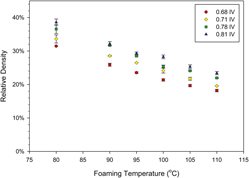Crossref Citations
This article has been cited by the following publications. This list is generated based on data provided by
Crossref.
Guo, Huimin
Nicolae, Andrei
and
Kumar, Vipin
2015.
Solid-state poly(methyl methacrylate) (PMMA) nanofoams. Part II: Low-temperature solid-state process space using CO2 and the resulting morphologies.
Polymer,
Vol. 70,
Issue. ,
p.
231.
Guo, Huimin
and
Kumar, Vipin
2015.
Effect of glass transition temperature and saturation temperature on the solid‐state microcellular foaming of cyclic olefin copolymer.
Journal of Applied Polymer Science,
Vol. 132,
Issue. 28,
Guo, Huimin
Nicolae, Andrei
and
Kumar, Vipin
2016.
Fabrication of High Temperature Polyphenylsulfone Nanofoams Using High Pressure Liquid Carbon Dioxide.
Cellular Polymers,
Vol. 35,
Issue. 3,
p.
119.
Gedler, G.
Antunes, M.
Velasco, J.I.
and
Ozisik, R.
2016.
Enhanced electromagnetic interference shielding effectiveness of polycarbonate/graphene nanocomposites foamed via 1-step supercritical carbon dioxide process.
Materials & Design,
Vol. 90,
Issue. ,
p.
906.
Wong, Anson
Guo, Huimin
Kumar, Vipin
Park, Chul B.
and
Suh, Nam P.
2016.
Encyclopedia of Polymer Science and Technology.
p.
1.
Ronkay, Ferenc
Molnar, Bela
and
Dogossy, Gabor
2017.
The effect of mold temperature on chemical foaming of injection molded recycled polyethylene-terephthalate.
Thermochimica Acta,
Vol. 651,
Issue. ,
p.
65.
Xia, Tian
Xi, Zhenhao
Liu, Tao
and
Zhao, Ling
2017.
Solid state foaming of poly(ethylene terephthalate) based on periodical CO 2 -renewing sorption process.
Chemical Engineering Science,
Vol. 168,
Issue. ,
p.
124.
Lyu, Jiaxun
Liu, Tao
Xi, Zhenhao
and
Zhao, Ling
2018.
Cell characteristics of epoxy resin foamed by step temperature-rising process using supercritical carbon dioxide as blowing agent.
Journal of Cellular Plastics,
Vol. 54,
Issue. 2,
p.
359.
Jiang, Can
Han, Shuo
Chen, Shihong
Zhou, Hongfu
and
Wang, Xiangdong
2020.
Crystallization-induced microcellular foaming behaviors of chain-extended polyethylene terephthalate.
Cellular Polymers,
Vol. 39,
Issue. 6,
p.
223.
Kwon, Dong Eui
Aregay, Mulugeta G.
Park, Byung Kyu
and
Lee, Youn-Woo
2021.
Preparation of polyethylene terephthalate foams at different saturation temperatures using dual methods of supercritical batch foaming.
Korean Journal of Chemical Engineering,
Vol. 38,
Issue. 12,
p.
2560.
Yeh, Shu-Kai
Demewoz, Nigus Maregu
and
Kurniawan, Vania
2021.
Controlling the structure and density of PMMA bimodal nanocellular foam by blending different molecular weights.
Polymer Testing,
Vol. 93,
Issue. ,
p.
107004.
Pan, Junjie
Chen, Feng
Cabrera, Eusebio Duarte
Min, Zhiyu
Ruan, Shilun
Wu, Min
Zhang, Dan
Castro, Jose M
and
Lee, L James
2021.
Carbon particulate and controlled-hydrolysis assisted extrusion foaming of semi-crystalline polyethylene terephthalate for the enhanced thermal insulation property.
Journal of Cellular Plastics,
Vol. 57,
Issue. 5,
p.
695.
